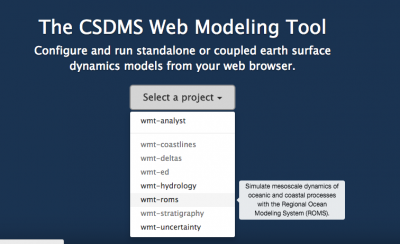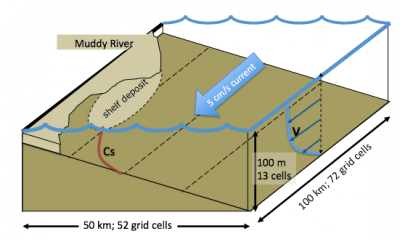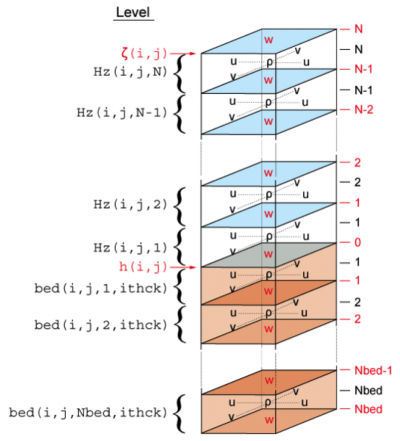Labs WMT ROMSLIte RiverPlume
Introduction to Regional Ocean Modeling - River Plume 2 base case and ROMS grids
This lab has been designed and developed by Courtney Harris, Julia Moriarty, and Danielle Tarpley Virginia Institute of Marine Sciences, Gloucester Point, VA
with assistance of Irina Overeem, CSDMS, University of Colorado, CO
Classroom organization
This lab is the first in a series of introduction to a Web-Based version of the Regional Ocean Modeling System (ROMS), designed for inexperienced users. ROMS is a three-dimensional hydrodynamic ocean model (see Haidvogel et al. 2008; myroms.org). ROMS solves the conservation of mass and three-dimensional momentum equations and includes transport equations for temperature and salinity. The version implemented here also accounts for suspended sediment transport and deposition, following Warner et al. (2008). Here we present a basic configuration of ROMS in the framework of the Web Modeling Tool (WMT). This series of labs is designed for inexperienced modelers to gain some experience with running a numerical model, changing model inputs, and analyzing model output. The example provided looks at the influence of a river plume on the hydrodynamics and sediment transport within an idealized continental shelf. Basic theory is presented in these slides File:ROMS Lite Introduction.pptx.
This lab will likely take ~ 3hours to complete in the classroom.
If you have never used the Web Modeling Tool (WMT), learn how to use it here. The WMT allows you to set up simulations, but once you are ready to run them, you will need an account on the CSDMS supercomputer to successfully submit and run your job.
More information on getting an account can be found here HPCC Access. Note that getting permission for access takes a few days after your request.
Learning objectives
Skills
- familiarize with a basic configuration of the Regional Ocean Modeling System
- hands-on experience with visualizing NetCDF output with Panoply.
Topical learning objectives: Learn about
- grids in oceanographic modeling
- the conservation of momentum, continuity equation and conservation of tracers into a specific advection-diffusion scheme
- the evolution of river freshwater and sediment plumes entering into a marine basin
Lab Notes
>> Open a new browser window and open the Web Modeling Tool here and select the ROMS project
>> This WMT project is unique in that there is only a single driver, ROMS-Lite. It is a pre-compiled instance of the larger ROMS system specially configured for teaching use.


The numerical experiment has been designed to use idealized inputs and a configuration considered representative for a medium-sized river draining into the coastal ocean. The incoming river carries freshwater and suspended sediment into the salty ocean water. The river discharge is held constant for the duration of the simulation at 1500 m3/sec. The model domain is 52 by 72 gridcells, and each gridcells has dimensions of dx=500m and dy= 750m; so that the total model domain is about 2.5 km in the across-shelf coordinate, and 54 km in the along-shelf direction. Water depths vary from very shallow at the shoreline (15 m) to ~200 m offshore. In this experiment, ROMS is configured to have 20 vertical layers in the water column, and stores 10 layers to represent the ocean bed.
Sketch the planview grid set-up in ROMS for a single grid cell (hint this setup is known as an Arakawa-C grid). How/where do you evaluate salinity in one of these grid cells?
>> Run the base case configuration. It is purposely configured to be short and fast (it takes only a few minutes to run). Download the zip file with your simulation output from the run status window

The ocean_riverplume2.nc file contains all of the important model output in a NetCDF file. Typically the tracer quantities, like salinity and suspended sediment concentration, can be plotted as a two-dimensional plot of eta-rho (x-axis) and xhi_rho (y-axis).
Plot a stack of planview maps of salinity. How far offshore does the river plume still affect the ocean conditions? Up to what depth is salinity noticeably affected by the freshwater?
This feature is a coast-hugging plume, also called a 'surface trapped plume'. Why? Do you know of, or can you find real-world examples of coast-hugging plumes?
>> Set up an additional WMT ROMS-Lite simulation for the same river and ocean conditions, but double the suspended sediment concentrations. Run this simulation and download the output.
Plot plan view maps of the final time slice for the mud_01 concentration at the water surface. Do this both for our 'base case' as well as for the 'high concentration' simulation. How do the two results differ from each other? Does a river plume with a higher sediment concentration travel further out offshore? What do you think controls this distance?
References and More information
- Ocean forecasting in terrain-following coordinates: Formulation and skill assessment of the Regional Ocean Modeling System, Haidvogel, D. B., Arango, H., Budgell, W. P., Cornuelle, B. D., Curchitser, E., Di Lorenzo, E., ... & Levin, J. (2008). Journal of Computational Physics, 227(7), 3595-3624.
- The regional oceanic modeling system (ROMS): a split-explicit, free-surface, topography-following-coordinate oceanic model, A. F. Shchepetkin, J. C. McWilliams, Ocean Modelling 9 (2005) 347–404
- Much more information on ROMS community help pages
- Arakawa, A.; Lamb, V.R. (1977). "Computational design of the basic dynamical processes of the UCLA general circulation model". Methods of Computational Physics 17. New York: Academic Press. pp. 173–265.
- Warner, J.C., C.R. Sherwood, R.P. Signell, C.K. Harris, and H. Arango. 2008. Development of a three-dimensional, regional, coupled wave-, current-, and sediment-transport model. Computers and Geosciences, 34: 1284 – 1306; doi: 10.1016/j.cageo.2008.02.012.


